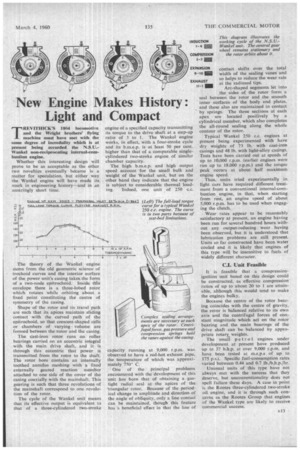New Engine Makes History: Light and Compact
Page 55

If you've noticed an error in this article please click here to report it so we can fix it.
REVITHICK'S 1804 locomotive and the Wright brothers' flying machine must have me( with the same degree of incredulity which is at present being accorded the N.S.U.Wankel non-reciprocating internal-combustion engine.
Whether this interesting design will prove to be as acceptable as the other Iwo novelties eventually became is a matter for speculation, but either way the Wankel engine will have made its mark in engineering history—and in an amazingly short time.
The theory of the Wankel engine stems from the old geometric science of trochoid curves and the interior surface of the power unit's casing takes the form of a two-node epitrochoid. Inside tffis envelope there is a three-lobed rotor which rotates while orbiting about a fixed point constituting the centre of symmetry of the casing.
Shape of the rotor and its travel path are such that its apices maintain sliding contact with the curved path of the epitrochoid, so that crescent-shaped cells or chambers of varying. volume are formed between the rotor and the casing.
The cast-ironrotor runs on roller bearings carried on an eccentric integral with the main drive shaft, and it is through this eccentric that power is transmitted from the rotor to the shaft. The rotor bore contains an internally toothed annulus meshing with a fixed externally geared reaction member attached to one side of the cover of the casing coaxially with the rnainshaft. This gearing is such that three revolutions of the mainshaft correspond to one revolution of the rotor.
The cycle of the Wankel unit means that its effective output is equivalent to that of a three-cylindered two-stroke engine of a specified capacity transmitting its torque to the drive shaft at a step-up ratio of 3 to 1. The Wankel engine works, in effect, with a four-stroke cycle and its b.m.e.p. is at least 50 per cent. higher than that of a comparable singlecylindered two-stroke engine of similar chamber capacity.
The high b.m.e.p. and high output speed account for the small bulk and weight of the Wankel unit, but on the other hand they indicate that the engine is subject to considerable thermal loading. Indeed, one unit of 250 c.c.
capacity running at 9,000 r.p.m. was observed to have a red-hot exhaust pipe, the temperature of which was approximately 750° C.
One of the principal problems encountered with the development of this unit has been that of obtaining a gastight radial seal at the apices of the 'triangular rotor. Because of the periodical change in amplitude and direction of the angle of obliquity, only a line contact can he maintained, though this feature has a beneficial effoct in that the line of contact shifts over the total width of the sealing vanes and EXHAUST so helps to reduce the wear rate 11-1 EN at the radiused tips. Arc-shaped segments let into the sides of the rotor form a
seal between the rotor and the smooth inner surfaces of the body end plates,. and these also are maintained in contact by springs. The three sections at each apex are located positively by a cylindrical member, which also completes the all-round sealing along the whole contour of the rotor.
Typical Wankel 250 c.c. engines at present being experimented with have dry weights of 73 lb. with cast-iron casings and 48 lb. with light-alloy casings. Tests have been carried out at speeds of up to 10,000 r.p.m. (earlier engines were run up to 18,000 r.p.m.) and the torque peak occurs at about hall' maximum engine speed.
Thus, units tried experimentally in light cars have required different treatment from a conventional internal-combustion engine, in that, when starting from rest, an engine speed of about 5,000 r.p.m. has to be used when engaging the clutch.
Wear rates appear to be reasonably satisfactory at present, an engine having been run for several hundred hours without any output-reducing wear having been observed, but it is understood that lubrication problems are still present. Units so far constructed have been water cooled and it is likely that engines of this type will be insensitive to fuels of widely different character.
CI. Unit Feasible
It is feasible that a compressionignition unit based on this design could be constructed, as effective compression ratios of up to about 20 to 1 are attainable, although this would tend to make the engines bulky.
Because the centre of the rotor bearing coincides with the centre of gravity, the rotor is balanced relative to its own axis and the centrifugal forces of constant magnitude which act on the rotor bearing and the main bearings of the drive shaft can be balanced by appropriate rotary...weights.
The small petrol engines under development at present have produced up to 37 b.h.p. at over 9,000 r.p.m. and have been tested at m.e.p.s of up to 175 p.s.i. Specific fuel-consumption rates varied between 0.44 and 0.7 lb./b.h.p./1-ir.
Unusual units of this type have not always met with the success that they deserve, but unconventionality does not spell failure these days. A case in point is the Rootes three-cylindered two-stroke oil engine, and it is through such concerns as the Rootes Group that engines of the Wankel type are likely to receive commercial success.




















































































































